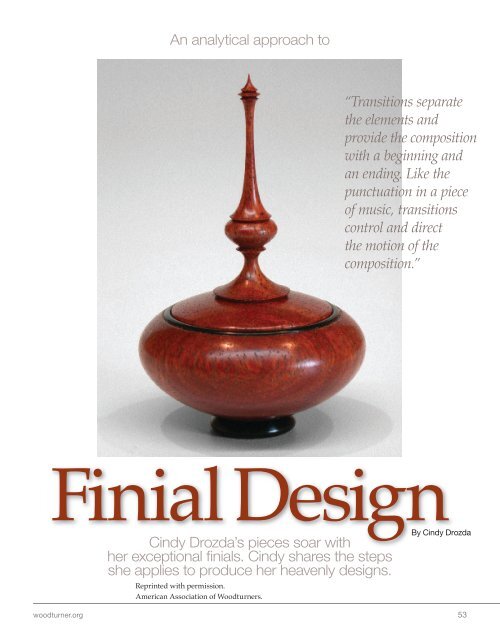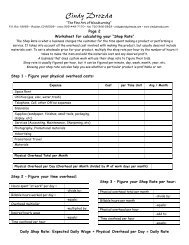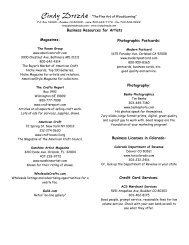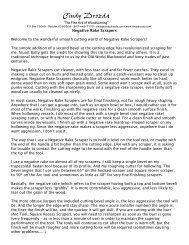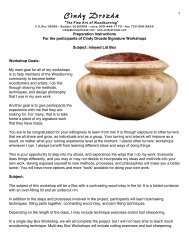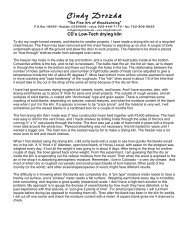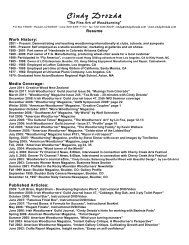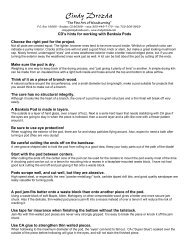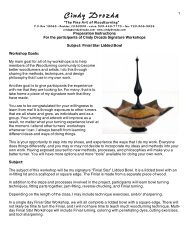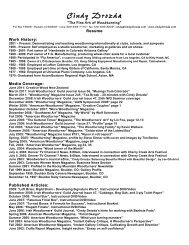Finial Design Article - Cindy Drozda
Finial Design Article - Cindy Drozda
Finial Design Article - Cindy Drozda
Create successful ePaper yourself
Turn your PDF publications into a flip-book with our unique Google optimized e-Paper software.
An analytical approach to<br />
“Transitions separate<br />
the elements and<br />
provide the composition<br />
with a beginning and<br />
an ending. Like the<br />
punctuation in a piece<br />
of music, transitions<br />
control and direct<br />
the motion of the<br />
composition.”<br />
<strong>Finial</strong> <strong>Design</strong>By <strong>Cindy</strong> <strong>Drozda</strong><br />
<strong>Cindy</strong> <strong>Drozda</strong>’s pieces soar with<br />
her exceptional fi nials. <strong>Cindy</strong> shares the steps<br />
she applies to produce her heavenly designs.<br />
Reprinted with permission.<br />
American Association of Woodturners.<br />
woodturner.org<br />
53
I<br />
admit it, I do love finials.<br />
I love the way a finial<br />
completes the personality of<br />
a lidded vessel, then invites you to<br />
reach out and lift up the lid. In my<br />
eyes, a well-done finial is<br />
a pleasing and lively composition<br />
that adds another dimension to<br />
a piece.<br />
As an artist, I love having the<br />
opportunity to express motion<br />
and energy through a finial, and<br />
I enjoy its technical challenge.<br />
By adding a finial to my vessel,<br />
I also get to indulge in my love<br />
of working in a small scale, even<br />
when I’m making a larger piece.<br />
Precise spindle work requires<br />
intense energy. There is little room<br />
for error, and the tiniest cut makes<br />
a huge difference in the finished<br />
piece. Planning the piece is critical;<br />
finial turning is not one of those<br />
projects where I want to “let the<br />
wood decide” what the finished<br />
piece will look like.<br />
The goal of this article is to<br />
explore the process of analyzing<br />
forms and compositions. Using my<br />
philosophy on finial design as an<br />
example, I present a vocabulary<br />
for describing the positive and<br />
negative design aspects of a<br />
turning. To illustrate this philosophy,<br />
I have made an 11"-tall<br />
large-scale model of one of my<br />
favorite finials. Two more models<br />
in the same scale are examples<br />
of variations on this design that I<br />
consider to have missed the mark.<br />
<strong>Finial</strong> #3 is my vision of success;<br />
#1 and #2 are the variations.<br />
Just to set things straight, I am<br />
not suggesting that my finial is the<br />
“best” finial design or that I know<br />
more about “the perfect finial”<br />
than anyone else. There is no such<br />
thing as “the perfect” shape, finial,<br />
or composition.<br />
Line describes<br />
form<br />
Woodturners often say<br />
that the form (shape)<br />
of a piece is the most<br />
important design feature.<br />
When I look at vessel and<br />
bowl forms, I see form as<br />
lines. The curve of a bowl,<br />
for example, is a single<br />
curved line. To me, this<br />
line expresses motion.<br />
The motion changes<br />
momentum and speed<br />
with the radius of the<br />
curve and the length of<br />
the line.<br />
What I refer to as the<br />
elements of a design are<br />
the composition sections<br />
where the motion of the line<br />
is interrupted, is stopped, or<br />
changes direction.<br />
An element is a form that stands<br />
alone. If we look at my finials,<br />
I consider the individual elements<br />
to be those separated by fillets<br />
or V-grooves.<br />
Combining elements in the<br />
proper proportions establishes the<br />
energy of the composition.<br />
I see my finial taking the motion<br />
of the top line of the vessel and<br />
continuing it upward so that it<br />
reaches for the sky. I want the<br />
finial to complete my vessel with a<br />
feeling of lightness and liveliness,<br />
as if it were dancing to music. To<br />
accomplish this, the elements are<br />
dramatically separated.<br />
Of course, this is not the only<br />
way to use finials—different<br />
designs might display different<br />
energy. My work expresses its<br />
unique combination of energy to<br />
evoke emotions. Another person’s<br />
work might be saying something<br />
completely different and would<br />
use different elements in a<br />
<strong>Finial</strong> 1 <strong>Finial</strong> 2 <strong>Finial</strong> 3<br />
different way, just as not all pieces<br />
of music sound alike.<br />
My hope is that members<br />
reading this article will understand<br />
how to verbalize what they<br />
are expressing in their own work.<br />
I believe that knowing the<br />
“why” of design success is<br />
important. It is not enough to<br />
say “I like it.” In fact, to say simply<br />
“I like it” might only express a<br />
personal preference. I want the<br />
ability to say “this is or is not a<br />
successful piece of artwork, and<br />
here’s why.” Being conscious of<br />
what is happening in my own and<br />
other artists’ work enables me to<br />
strive for success without relying<br />
only on trial and error.<br />
One exercise that I use is to<br />
make several examples of a design<br />
and look at them together. Taking<br />
time to just look and analyze often<br />
allows me to see what I would not<br />
have otherwise seen during the<br />
creative process. A real challenge<br />
for me is to look at work that I<br />
don’t personally care for and see it<br />
54 American Woodturner Spring 2006
as a successful piece of artwork.<br />
Traditional becomes<br />
contemporary<br />
A spindle turner takes pride in<br />
creating perfectly symmetrical<br />
beads and coves and smooth,<br />
straight tapers. Each cove or bead<br />
element represents a portion of a<br />
circle with the radius remaining<br />
constant throughout. <strong>Finial</strong> #2<br />
shows what my favorite finial<br />
design would look like if, keeping<br />
the same proportions as <strong>Finial</strong><br />
#3, the elements were shaped like<br />
traditional spindle elements.<br />
<strong>Finial</strong> #3 is my current favorite<br />
finial design. I have taken the<br />
traditional bead and made it<br />
asymmetrical, with the widest<br />
diameter above the centerline.<br />
The coves are not constant radius<br />
coves. They are continually<br />
changing in radius as the motion<br />
initially accelerates, slows down to<br />
almost a stop, and then accelerates<br />
again to the top of the next fillet.<br />
The fillets are undercut to give<br />
them the drama and crispness of<br />
dance steps.<br />
By tweaking their proportions,<br />
the traditional spindle elements of<br />
beads, coves, tapers, and fillets<br />
are made into contemporary<br />
design elements.<br />
Proportion expresses<br />
motion<br />
In a symmetrically turned object,<br />
you can simplify the study of<br />
proportion into two dimensions.<br />
Each element of the design has a<br />
height and a diameter. An abstract<br />
design adds a third dimension,<br />
altering your perception of the<br />
object’s proportions.<br />
I find it easier to understand<br />
proportions when looking at two<br />
dimensions, rather than three.<br />
With only height and diameter<br />
to plan for, I am able to draw my<br />
finial designs on graph paper<br />
before turning.<br />
In <strong>Finial</strong> #1, I put my<br />
contemporary elements together<br />
in static proportions. I repeated<br />
the diameters, making the beads<br />
too bold while causing the coves<br />
to lose their dramatic dancing<br />
effect. The upper and lower cove<br />
elements were made too close to<br />
the same height, which stalled<br />
the upward motion of the finial.<br />
The overall effect is clunky when<br />
compared to <strong>Finial</strong> #3.<br />
The Golden Mean, a ratio of<br />
1:1.618 (often approximated as<br />
1 /3 : 2 /3), has occurred in nature<br />
and in human-made objects and<br />
structures as far back as recorded<br />
history goes. When people are<br />
asked to pick the object they<br />
prefer, the one with proportions<br />
that comes close to the Golden<br />
Mean wins every time. Even when<br />
it is not perfectly measured out,<br />
we find that getting close to the<br />
Golden Mean is pleasing to the<br />
critical human eye.<br />
In my experience, trying to<br />
have every element in a complex<br />
composition interact using Golden<br />
Mean proportions would have<br />
me tearing my hair out! Efforts to<br />
design a finial using a calculator<br />
can result in a static design. It is<br />
usually more visually exciting<br />
to incorporate Golden Mean<br />
proportions in only one or two<br />
relationships between elements.<br />
My view of the Golden Mean<br />
is that it is a place to start, not a<br />
strict set of rules to follow. When<br />
designing a finial, I like the<br />
results that I get when I try not to<br />
duplicate any of the dimensions<br />
within the piece. That’s as close as<br />
I get to a “rule to follow.”<br />
Transitions are the<br />
punctuation<br />
When motion is interrupted or<br />
redirected, I call that “transition.”<br />
Points like the joint between the lid<br />
and the vessel—where the piece<br />
contacts the surface it sits on—or<br />
the smooth change of direction<br />
in an ogee curve, are transitions<br />
in the piece. Transitions separate<br />
the elements and provide the<br />
composition with a beginning and<br />
an ending. Like the punctuation<br />
in a piece of music, transitions<br />
control and direct the motion of<br />
the composition.<br />
A symphony in wood<br />
An orchestral symphony<br />
is a blending of individual<br />
instruments, all playing their<br />
separate parts, into a composition<br />
that is much greater than the sum<br />
of those parts. This is the same<br />
way that I look at a painting or<br />
drawing composed of lines and<br />
color. A turned piece, in a similar<br />
manner, is a composition of shapes<br />
and textures with each element<br />
playing its part.<br />
Every composer works in a<br />
different way, and a wide range<br />
of music appeals to a wide range<br />
of personal tastes. When we<br />
woodturners express our passions<br />
for life through our work, the<br />
result is artwork that enriches<br />
our culture.<br />
When we all openly share our<br />
personal knowledge and feelings<br />
with the rest of the woodturning<br />
community, we grow further and<br />
at a much greater rate than we ever<br />
could on our own.<br />
And now it’s your turn .…<br />
<strong>Cindy</strong> <strong>Drozda</strong> (cindyrozda.com) lives<br />
in Boulder, Colorado. <strong>Cindy</strong> will be one<br />
of the demonstrators at the Louisville<br />
symposium.<br />
woodturner.org<br />
55


